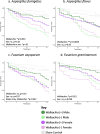Wolbachia enhances the survival of Drosophila infected with fungal pathogens
- PMID: 39934832
- PMCID: PMC11817339
- DOI: 10.1186/s12915-025-02130-0
Wolbachia enhances the survival of Drosophila infected with fungal pathogens
Abstract
Background: Wolbachia bacteria of arthropods are at the forefront of basic and translational research on multipartite host-symbiont-pathogen interactions. These vertically transmitted microbes are the most widespread endosymbionts on the planet due to factors including host reproductive manipulation and fitness benefits. Importantly, some strains of Wolbachia can inhibit viral pathogenesis within and between arthropod hosts. Mosquitoes carrying the wMel Wolbachia strain of Drosophila melanogaster have a greatly reduced capacity to spread viruses like dengue and Zika to humans. While significant research efforts have focused on viruses, relatively little attention has been given to Wolbachia-fungal interactions despite the ubiquity of fungal entomopathogens in nature.
Results: Here, we demonstrate that Wolbachia increase the longevity of their Drosophila melanogaster hosts when challenged with a spectrum of yeast and filamentous fungal pathogens. We find that this pattern can vary based on host genotype, sex, and fungal species. Further, Wolbachia correlates with higher fertility and reduced pathogen titers during initial fungal infection, indicating a significant fitness benefit. Finally, RNA sequencing results show altered expression of many immune and stress response genes in the context of Wolbachia and fungal infection, suggesting host immunity may be involved in the mechanism.
Conclusions: This study demonstrates Wolbachia's protective role in diverse fungal pathogen interactions and determines that the phenotype is broad, but with several variables that influence both the presence and strength of the phenotype. It also is a critical step forward to understanding how symbionts can protect their hosts from a variety of pathogens.
Keywords: Drosophila; Wolbachia; Filamentous fungi; Immunity; Stress response; Yeast.
© 2025. The Author(s).
Conflict of interest statement
Declarations. Ethics approval and consent to participate: Not applicable. Consent for publication: Not applicable. Competing interests: The authors declare no competing interests.
Figures







Update of
-
Wolbachia enhances the survival of Drosophila infected with fungal pathogens.bioRxiv [Preprint]. 2023 Oct 11:2023.09.30.560320. doi: 10.1101/2023.09.30.560320. bioRxiv. 2023. Update in: BMC Biol. 2025 Feb 11;23(1):42. doi: 10.1186/s12915-025-02130-0. PMID: 37873081 Free PMC article. Updated. Preprint.
References
-
- Buchner P. Endosymbiosis of animals with plant microorganisms. New York: John Wiley & Sons; 1965.
-
- Douglas AE. Nutritional interactions in insect-microbial symbioses: Aphids and their symbiotic bacteria Buchnera. Ann Rev Entomol. 1998;43(1):17–37. - PubMed
-
- Yen JH, Barr AR. New hypothesis of the cause of cytoplasmic incompatibility in Culex pipiens L. Nature. 1971;232(5313):657–8. - PubMed
MeSH terms
Grants and funding
LinkOut - more resources
Full Text Sources
Other Literature Sources
Medical
Molecular Biology Databases

